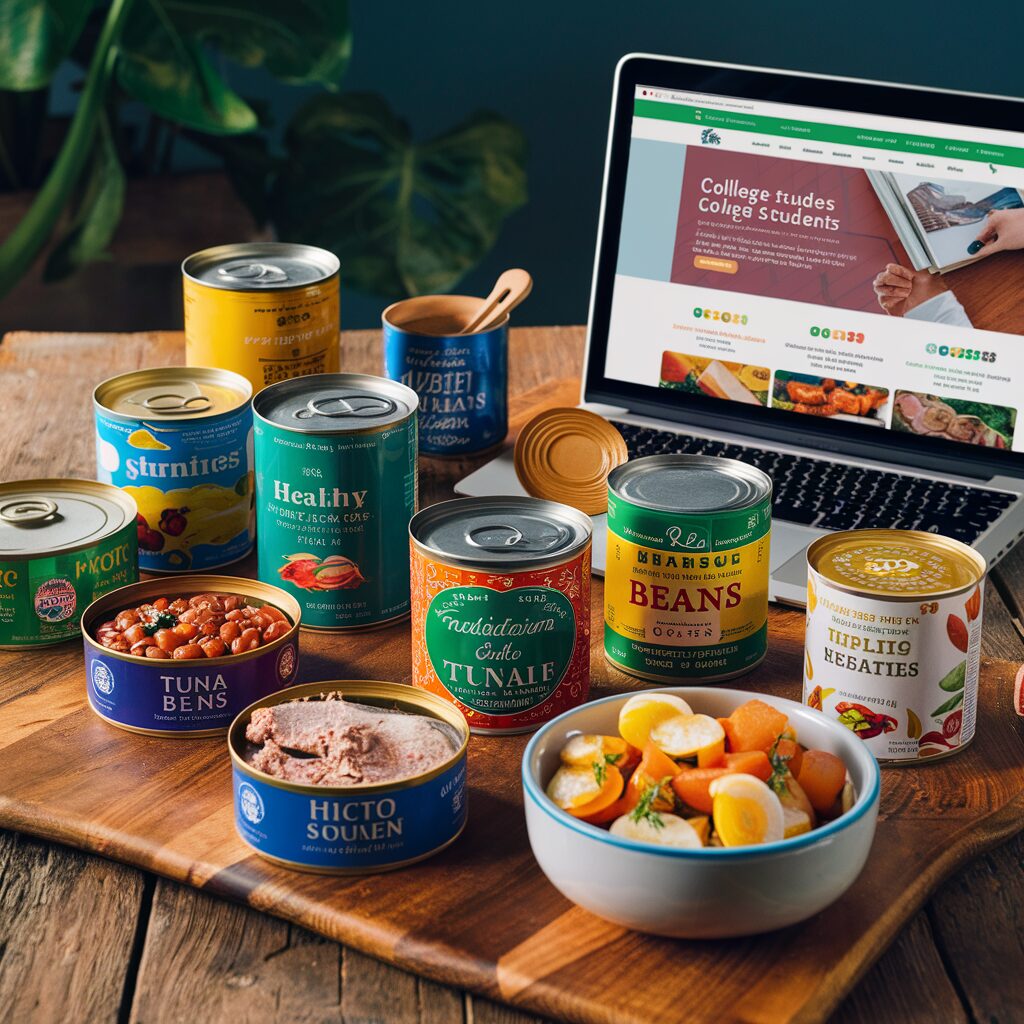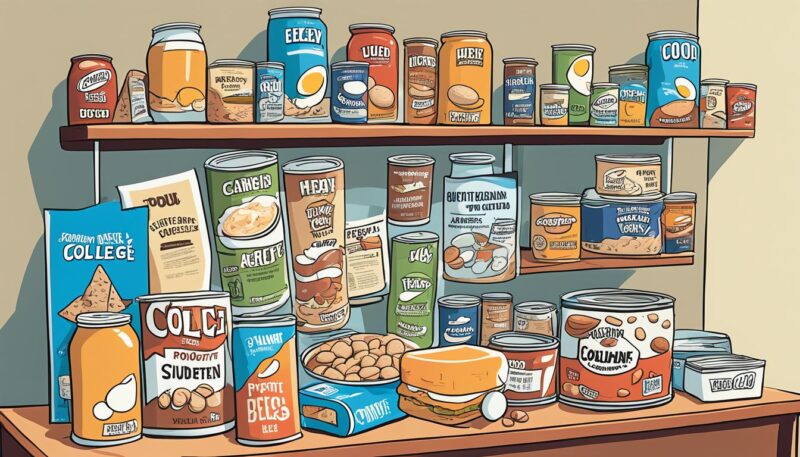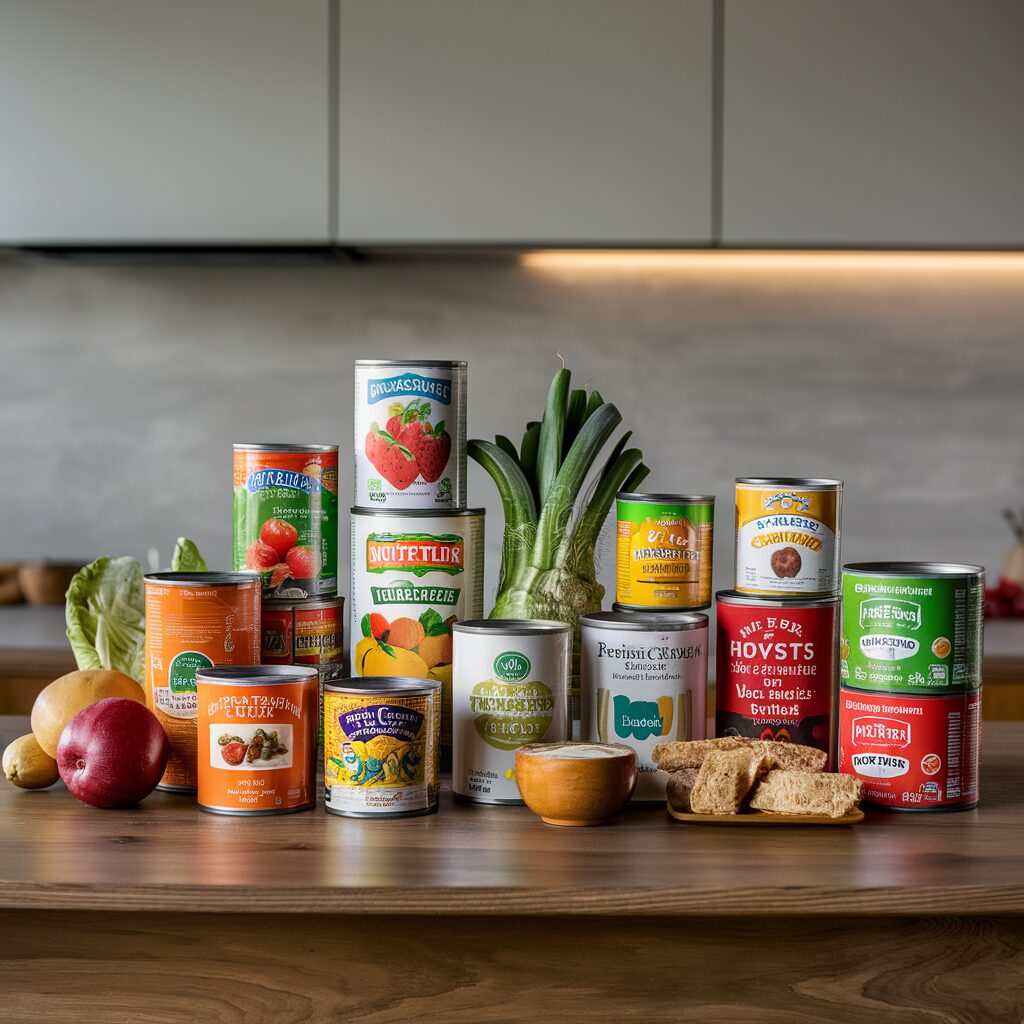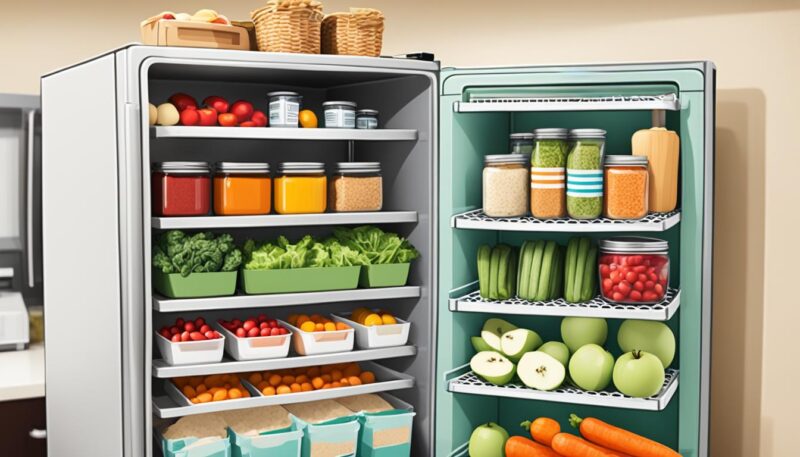Did you know that the average cost of food for a month as a college student is a whopping $667? That’s a significant amount of money for someone on a tight budget. However, there are ways to slash those expenses and still eat well. By creating a college student grocery list and being mindful of your spending, you can save money while nourishing your body.
To help you navigate the world of budget-friendly grocery shopping, we’ve compiled the ultimate grocery list for college students on a budget. This list includes essential pantry items, easy meal ingredients, and affordable grocery picks that will keep you nourished without breaking the bank.
Key Takeaways
- Create a college student grocery list to stay organized and avoid overspending.
- Canned goods, such as beans and soups, provide affordable and nutritious options.
- Consider affordable meat options like canned tuna and frozen chicken.
- Choose budget-friendly produce, such as onions, bananas, and frozen vegetables.
- Follow tips like using cashback apps and shopping with roommates to save money on groceries.
Healthy Canned Goods for College Students on a Budget

Canned goods are a lifesaver for college students on a tight budget. Not only do they offer convenience, but they also have a long shelf life and are often more affordable than fresh alternatives. Incorporating healthy canned goods into your college student grocery list is a smart way to stay nourished while sticking to your budget.
According to the first source, there is a wide range of healthy canned goods that are perfect for college students on a budget. These items can be used as staple ingredients in various meals, providing essential nutrients without breaking the bank.
Must-Have Canned Goods
- Green beans
- Corn
- Kidney beans
- Canned soup
- Black beans
- Peas
- Carrots
- Chicken breasts
- Tuna
- Chili
- Broth
These canned goods are versatile and can be incorporated into a variety of recipes, from soups and stews to salads and casseroles. They provide a good source of protein, fiber, vitamins, and minerals, ensuring that you maintain a balanced diet on a college student budget.
Sample Recipe: Budget-Friendly Chicken and Black Bean Tacos
Here’s a quick and easy recipe using two budget-friendly canned goods: chicken breasts and black beans. These tacos are not only tasty but also packed with protein and fiber.
Ingredients:
- 1 can of chicken breasts
- 1 can of black beans
- Taco shells or tortillas
- Shredded lettuce
- Diced tomatoes
- Sour cream (optional)
- Shredded cheese (optional)
- Salsa (optional)
Instructions:
- Drain the chicken breasts and black beans.
- In a skillet, heat the chicken and black beans over medium heat until warmed through.
- Warm the taco shells or tortillas according to the package instructions.
- Fill each taco shell or tortilla with the chicken and black bean mixture.
- Top with shredded lettuce, diced tomatoes, and any optional toppings you desire.
- Serve and enjoy!
These chicken and black bean tacos are not only affordable but also customizable to suit your taste preferences. Feel free to add your favorite toppings and make this recipe your own.
Affordable Meat and Protein Options for College Students
When it comes to putting together a college student grocery list, finding affordable meat and protein options is essential. Meats can be expensive, but there are budget-friendly choices that can still provide you with the protein you need to stay energized and nourished. By including these options in your grocery shopping, you can enjoy a variety of protein-rich meals without straining your college student budget.
Affordable Meat Options
To help you make the most of your college student grocery budget, consider adding these affordable meat options to your shopping list:
- Canned tuna
- Canned chicken breast
- Ground beef
- Ground turkey
- Chicken thighs
- Tilapia
- Cod
- Pork loin
- Pork shoulder
- Deli meat
- Frozen meatballs
These options not only offer a good source of protein but also provide versatility in your meal planning. You can incorporate them into various dishes, such as salads, sandwiches, stir-fries, and pasta dishes, to create satisfying and nutritious meals.
Comparison of Meat Prices
| Meat Option | Average Price (per pound) |
|---|---|
| Canned tuna | $2.99 |
| Canned chicken breast | $3.49 |
| Ground beef | $4.99 |
| Ground turkey | $3.99 |
| Chicken thighs | $2.49 |
| Tilapia | $4.49 |
| Cod | $5.99 |
| Pork loin | $3.99 |
| Pork shoulder | $2.99 |
| Deli meat | $4.99 |
| Frozen meatballs | $3.99 |

As you can see, there are several affordable options available that fit within a college student budget. By incorporating these meats into your meals, you can enjoy a variety of flavors and ensure you’re getting the necessary protein for your diet without breaking the bank.
Budget-Friendly Produce for College Students on a Budget

Buying affordable produce is essential for college students on a budget. To ensure you can enjoy a variety of fruits and vegetables without breaking the bank, consider the following tips:
- Choose produce that is in season: Seasonal fruits and vegetables are often more affordable due to their abundance in the market. Additionally, they tend to be fresher and have better flavor. Opt for seasonal options whenever possible.
- Consider frozen produce: Frozen fruits and vegetables can be a great budget-friendly option. They are often less expensive than fresh produce and can be just as nutritious. Plus, they are convenient as they are already cleaned and prepped.
- Add the following budget-friendly produce items to your grocery list:
| Fruits | Vegetables |
|---|---|
| Bananas | Onions |
| Oranges | Celery |
| Berries (strawberries, blueberries, etc.) | Garlic |
| Apple | Spinach |
| Cantaloupe | Tomatoes |
| Pears | Lettuce |
| Watermelon | Cucumbers |
| Lemon | Zucchini |
| Orange | |
| Kiwi | Cauliflower |
| Limes | Broccoli |
| Grapefruit | Squash |
| Pineapple | Potatoes |
| Figs | Sweet potatoes |
These affordable produce options provide a variety of nutrients and can be used in different recipes to create affordable and healthy meals. Don’t forget to incorporate them into your college student grocery list and get creative with your meal planning!
Tips for Grocery Shopping on a Budget as a College Student

As a college student, saving money on groceries is crucial.
When it comes to grocery shopping on a budget, there are several helpful strategies you can employ to stretch your dollars further.
Firstly, consider making budget-friendly choices by utilizing recipes that call for similar ingredients. This way, you can purchase items in bulk and save money in the long run.
Another great tip is to opt for generic store brands instead of expensive name brands.
In many cases, the generic versions offer the same quality but at a lower price point.
Additionally, taking advantage of cashback apps like Ibotta can help you earn money back on your grocery purchases.
Simply scan your receipts and unlock cashback rewards that can be redeemed later.
To save even more, try splitting the cost of groceries with your roommates.
Coordinating your shopping trips and pooling resources can help everyone stay within their budget.
Two more practical tips are to avoid going to the store on an empty stomach, as hunger can lead to impulse purchases, and to prioritize using reusable grocery bags to avoid the extra fees charged for disposable bags.
These small habits can add up to significant savings over time.
By implementing these grocery shopping strategies, college students can successfully navigate their budgets and make the most of their grocery shopping experience.
With a little planning and smart decision-making, saving money on groceries is well within reach for students.
FAQ
What items should be on a budget-friendly college grocery essentials list?
The budget-friendly college grocery essentials list should include pantry items, easy meal ingredients, and affordable grocery picks. Some examples of pantry items are canned goods like green beans, corn, kidney beans, canned soup, black beans, peas, carrots, chicken breasts, tuna, chili, and broth. Additionally, affordable meat options like canned tuna, canned chicken breast, ground beef, ground turkey, chicken thighs, tilapia, cod, pork loin, pork shoulder, deli meat, and frozen meatballs can be considered. Lastly, for produce, options such as onions, celery, garlic, spinach, tomatoes, lettuce, bananas, oranges, berries, cucumbers, zucchini, mushrooms, cauliflower, broccoli, squash, potatoes, and sweet potatoes are great additions to the list.
How can college students save money on groceries?
There are various strategies that college students can employ to save money on groceries. Some tips include using recipes that require the same ingredients, buying generic store brands instead of name brands, utilizing cashback apps like Ibotta, splitting the cost with roommates, avoiding shopping on an empty stomach, and prioritizing reusable grocery bags to save on bag fees. These tips can help college students stick to their budget and make the most out of their grocery shopping experience.




